This post is a suggestion for a private archaeological tour of Avdat, which was part of the Nabataean Kingdom. It is today officially Avdat is a World Heritage Site by UNESCO. The Nabateans were Arab tribes who inhabited northern Arabia and the Southern Levant in antiquity. Also, they spoke Aramaic. Originally the Nabateans were nomads who plied the caravan routes between the Arabian Peninsula and the Mediterranean coast.
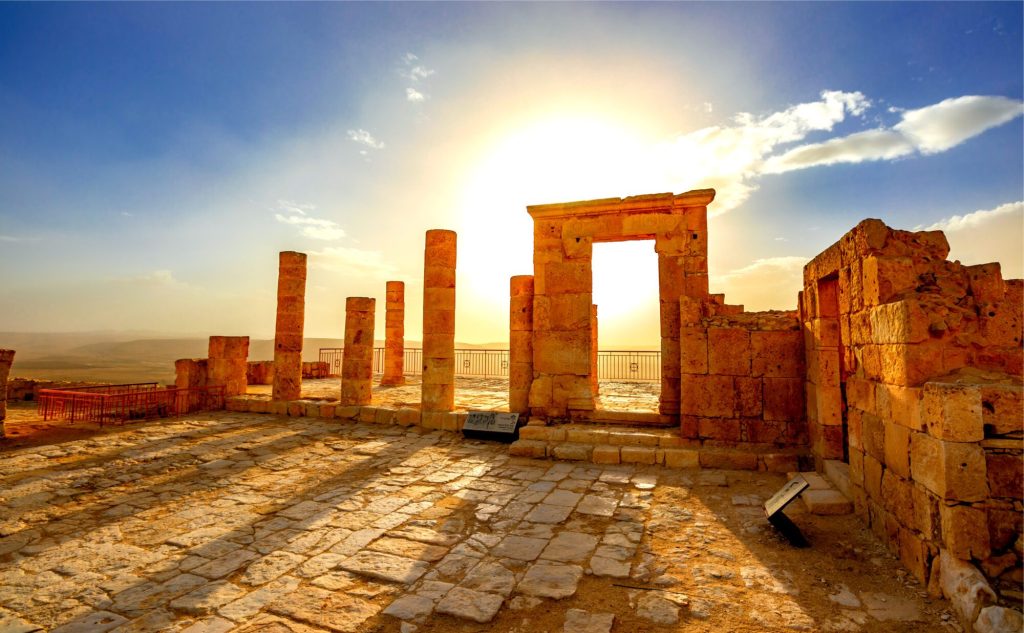
Private Archaeological Tour of Avdat
They grew wealthy trading in luxury goods such as frankincense and myrrh which they bundled and transported across the desert on pack animals. The Nabateans learned the art of controlling and storing water. Their talent for storing and distributing precious water in the middle of the rocky desert must have been noticed very quickly by visitors passing through. In fact, Diodorus Siculus, the first historian to talk about them, wrote this in the 1st century BCE.
“They fill the cistern with rainwater […] and place signs only known to them, but not by anyone else. They water their herds every three days so that, if they have to flee to the arid regions, the animals are not in constant need of water”
Diodorus Siculus
Although Petra that became the capital of the Nabataean Kingdom is the most famous Nabatean site, we have remains of many other Nabatean towns and settlements. One such site is Avdat (Oboda in Nabatean) which is located in the heart of the Negev desert. Avdat was a seasonal camping ground for Nabatean caravans traveling along the early Petra-Gaza road. It was the most important city on the Incense Route after Petra. It was founded in the 3rd century BCE, and inhabited by Nabateans, Romans, and Byzantines. The city’s original name was changed in honor of the Nabataean King Obodas I. Who, according to tradition, was revered as a deity and was buried here.
Private Archaeological Tour of Avdat: First Visits to Avdat
The very first European explorer that presumably visited Avdat in the modern period was Ulrich Jasper Seetzen. After making himself sufficiently at home with Arabic he began the part of his travels of which a full journal has been published. From April 1808 till March 1809, he described a series of the most instructive journeys in Jordan and Palestine and the wilderness of Sinai, including the Negev and particularly Avdat.
Simon Peter and St Paul Tour
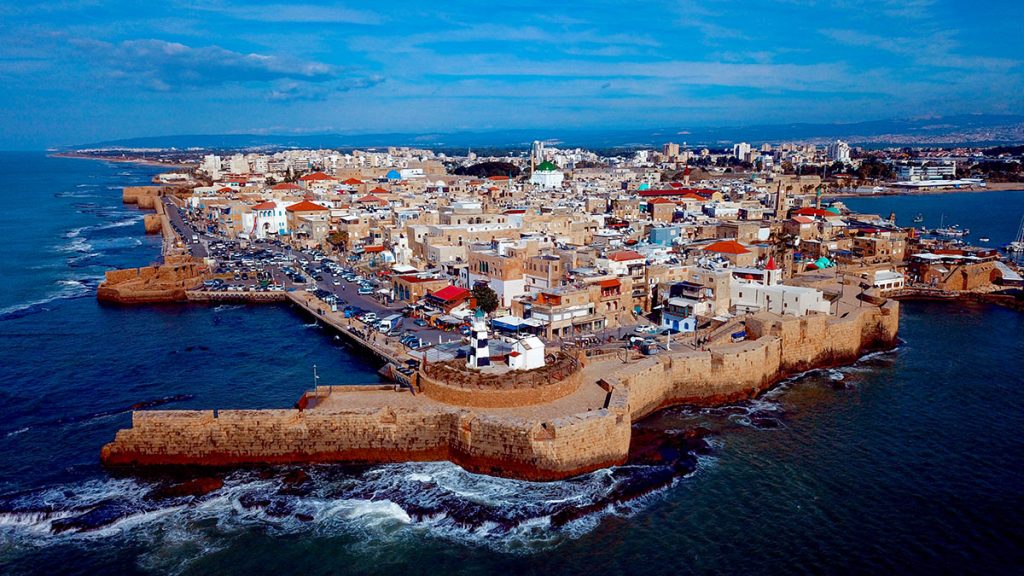
But the site couldn’t be Oboda (Avdat). An analysis of Seetzen’s itinerary proves that he could not have visited Oboda at all. His inaccurately drawn map, and especially his diary (1855:27-42), show that he took the most frequented caravan route. Moreover, he mentions finding insignificant ruins and expresses his disappointment (1855:43). Such a disappointment could hardly have been caused by a visit to Avdat. Which had much to offer, even to so inexperienced a traveler as Seetzen.
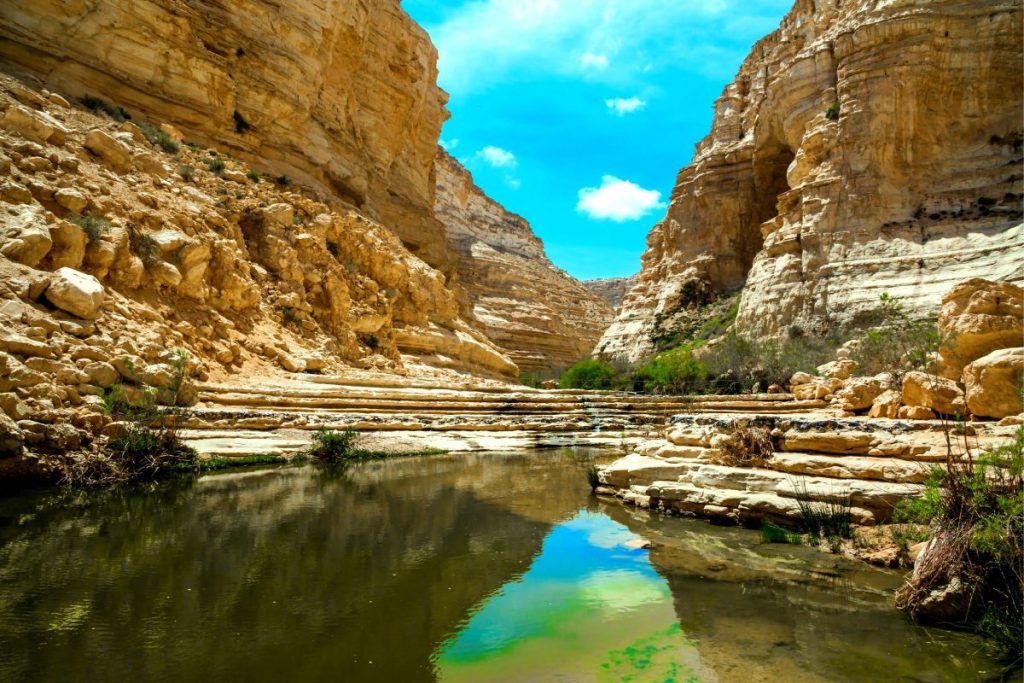
Private Archaeological Tour of Avdat: E. Robinson And E. Smith, 1838
Seetzen’s identification of Oboda did not remain unnoticed. In 1838 the Negev was visited by two better-informed scholars, Edward Robinson and Elihu Smith. During this year Robinson and Smith visited the Negev twice. But a quick glance at Robinson’s map, and his brilliant description, are enough to prove that they too also miscalculated and instead of reaching Avdat they reached Nessana
In 1869–70, explorers E. H. Palmer and C. F. Tyrwhitt Drake embarked on a journey across the Negev for a wide-ranging archaeological, historical, and environmental survey initiated by the Palestine Exploration Fund (PEF). But they took an entirely different route from their predecessors. Coming from the Sinai peninsula and on the western fringes of central Negev. The area was pristine in terms of research, mainly owing to the many dangers that awaited travelers venturing there.
Moreover, Palmer and Drake succeeded in crossing the entire Negev alone. And also in bringing back scientific evidence and valuable findings published by Palmer in his book The Desert of the Exodus (1871). They visited Oboda on March 28th, 1870. Palmer was the first European traveler to give an account of the ruins of Avdat. Palmer also drew the first plan of the site. The plan, very schematic, shows the fort with the reservoir in its center. However, Palmer’s greatest contribution is the correct identification of Oboda with Abdeh.
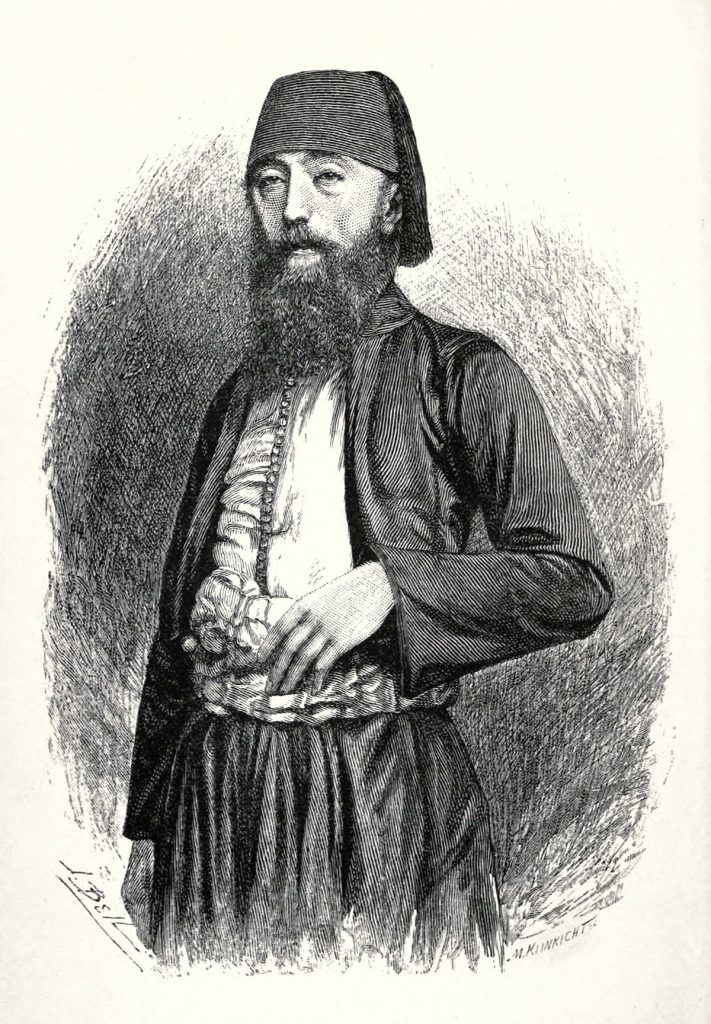
Excavations and Research in the Twentieth Century
The first scientific treatment of the ancient remains of Avdat we owe to Alois Musil. In 1901 he explored the Negev and later published a detailed survey of the area. His reports and photographs that he took were the basis for scholarly research for decades to come. The map of the Negev that he published in 1907 included the drawings of wadis, the locations of the Bedouin tribes, and the ruins of ancient sites, including Avdat. This map was used for all future maps till the publication of the British Mandate Palestine Grid in 1924. In the summer of 1902, he conducted an extensive survey of Avdat. He found it worthwhile to spend five days on the site. From August 28th to September 2nd, 1902. The numerous photographs that he took give an excellent idea of Avdat at the beginning of the century.
This is of great importance since parts of buildings that still stood to a substantial height at the time of Musil’s visit have since collapsed or been dismantled. Musil arrived at Avdat from Shivta (Sobata) and the first monument he saw at Avdat was the Bath House.
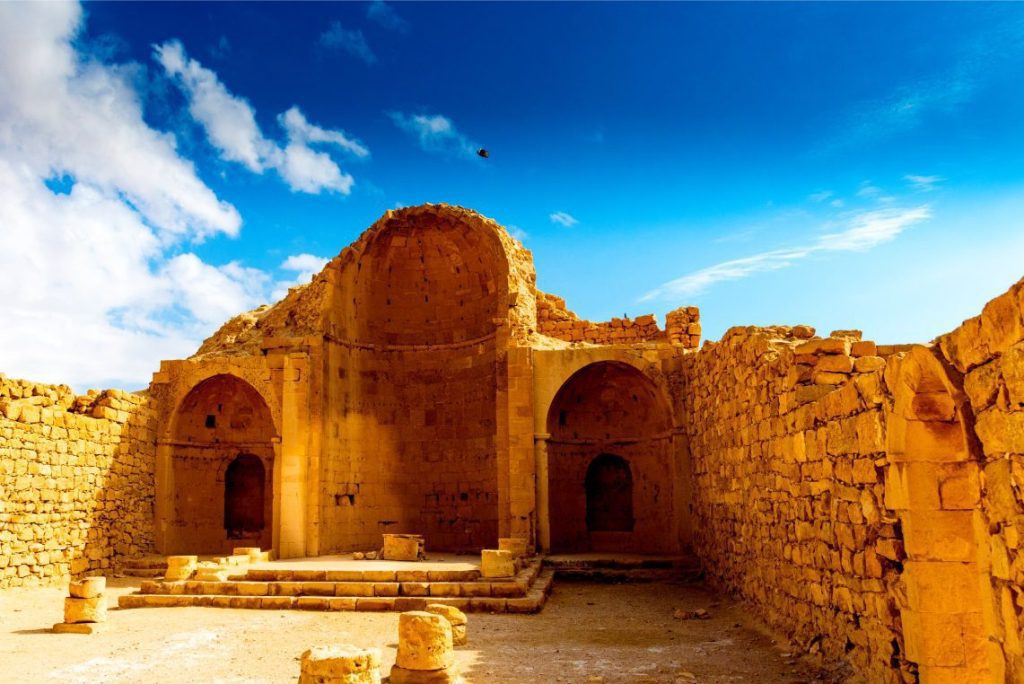
Private Archaeological Tour of Avdat: What Does Musil Find At Avdat
Musil identifies both churches at the site. Also, he discovers a Nabataean inscription built into a niche of a tower that says: “With good fortune, Zeus Oboda, help Irenius who built this tower with good augers in the year 188 with the help of the architect Wailos of Petra and Avithos”. Who was this “Zeus Oboda”? To the inhabitants of Avdat, their king (apparently Oboda II), after whom the city was named, was deified and likened to Zeus (the Greek god of the heavens). Years were counted from the establishment of Provincia Arabia in 106 CE, and therefore the year of the tower’s construction is 294 CE.
Since peace roamed the land of the Nabateans they did not have protective walls, only observation towers like this one. When Musil finished copying the inscription he tried to climb to the top of the tower. But a part of the wall tumbled and the inscription was buried beneath the ruins.
Moreover, Musil also finds the Roman camp to the northeast of the Acropolis. In fact, this was one of his greatest achievements. Also, Musil observed rounded towers, and two gates; Musil noted that the outer walls of the camp had been dismantled and their stones were carried away for the construction of the later citadel. During one week Musil collected a huge amount of information, a task which would normally require the efforts of a much larger team of archaeologists. None of the other scholars who visited Oboda in the coming years achieved as much as did Musil. We will talk about it more in length during our private tour of Avdat.
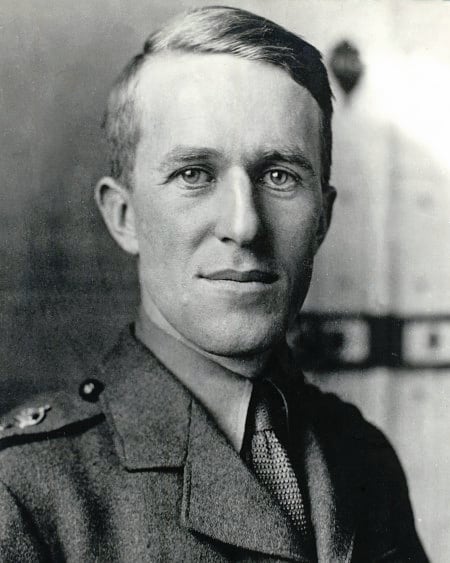
Private Archaeological Tour of Avdat: A. Jaussen, R. Savignac And H. Vincent, 1904
No less daring but more scientifically executed, was the survey made by Fathers Jaussen, Savignac, and Vincent during the week of February 5th-9th, 1904. The first hours of their stay on the site were devoted to a tour of the whole area, one of the objects of which was to locate drinking water in a cistern. They observed the remains of a grand staircase leading up to the Acropolis. Lamentably the staircase by which one reaches the Acropolis today is totally new and does not follow the line of the ancient staircase. They were the first to really find Nabataean inscriptions and graffiti. Also their photographs; descriptions and plans were an enormous help but neither of them and nor the archaeologists that followed them till 1937 never found that inscription Musil mentioned.
Apart from C.L Woolley and T.E Lawrence that excavated Avdat in 1914, the work done by T. Wiegand in 1916 and by the Deutsche Türkischen Denkmalschutz-Kommando in the towns of the Negev is of the utmost importance, as some ancient remains described in their report have since disappeared. This group of German scholars headed by Wiegand was well informed on the work done by their predecessors at Avdat. This prevented treatments of the same monuments all over again.
Wiegand too attempted to draw up a historical outline of Avdat. Basing his outline on Stephanus of Byzantium, he suggests a Nabatean origin for the town. The existence of the town in the Late Roman Period is by the inscription of 293 CE discovered by Musil.
Excavations Under Prof. Michael Avi-Yonah
The extensive excavations at Avdat were renewed in 1958 by the National Parks Authority, headed by Prof. Michael Avi-Yonah. In 1959-1961, Avraham Negev was conducting the excavations, he knew about the existence of the inscription from literature but he could not find it. In his book, Musil does not indicate exactly where he found the address, and when Negev checked the tower environment, he saw nothing. “The Roman Tower,” it was called, was one of the last sites excavated in Avdat in 1961.
Private Archaeological Tour of Avdat: The Features of the Nabataean Cities
This phenomenon of the Nabataean cities in the Negev is a unique vista in the Land of Israel. For centuries the Nabataean Arabs were nomads living in tents. During their roaming, they reached the Negev. A crucial area for them in order to control the trade routes. In order to seize this control over this route system, they needed sources of water in strategic locations. In this manner, those that led the convoys could equip themselves with food and camels. During the third and fourth century BCE, such centers were built in Avdat, Nitzana, and Haluza.
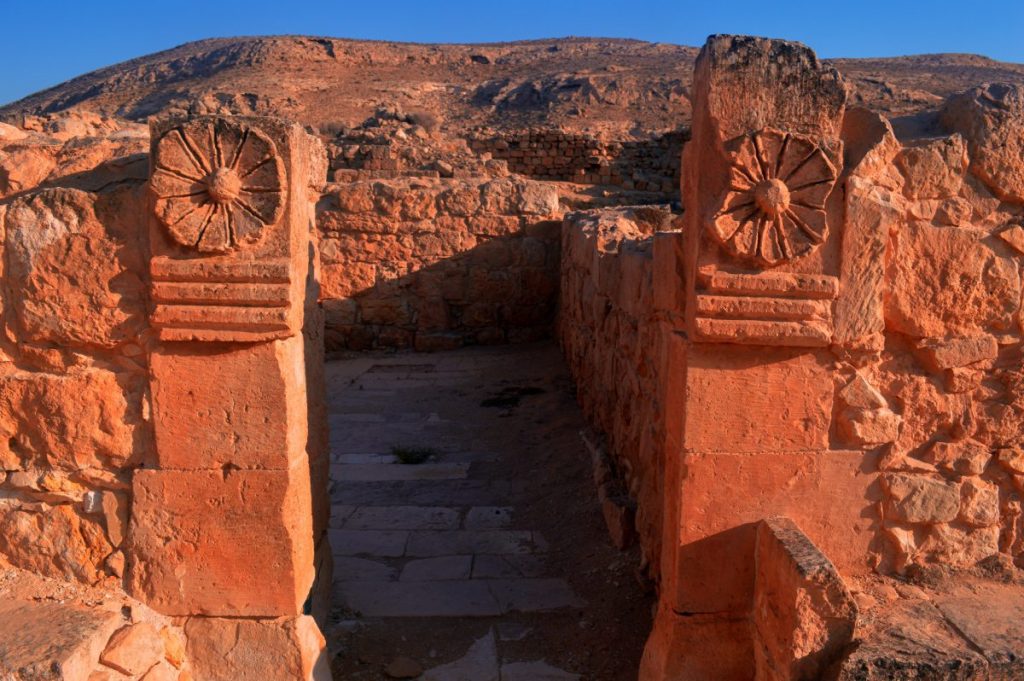
The Nabataeans did not plan their cities like classical cities. But their homes on other hand were considered big. Maybe to compensate for losing their freedom of roaming the desert freely and living in big tents. In the Late Roman Period and Byzantine Period, the Nabataean cities reached their zenith. The more noticeable changes began in the third century CE when Diocletian came to the East. A central feature of the Nabataean city is that it is not a walled city. But according to the Romans, a city can not be called a city unless it is walled. So suddenly we see walls in the Nabataean cities like in Mampsis.
In the Byzantine Period, even greater changes were taken. Cities with an Acropolis like Avdat and Nitzana surrounding them with a wall were even more impractical. So instead fortresses were built on top of the Acropolis. In Avdat there is no doubt the fortress is built for protective measures. With the idea that the population could flee to the fortress. On the other hand in Nitzana the little citadel there was some kind of an army barracks.
Memphis
The extensive excavations at Mampsis have revealed much new evidence for the art and architecture of a small provincial town of the Roman and Byzantine periods. The remains consist of a town area of ten acres within walls, two large caravanserais outside the walls, and cemeteries of all periods. The ruins were first called Mampsis in 1910 and this identification has not yet been disputed. Ptolemy in his Geography of the second century to the Common Era listed it among the towns of Idumaea; Eusebius in the Onomasticon names it as a station of a Roman garrison. The Madaba mosaic map of the sixth century to the Common Era describes it by an arched gate protected by two towers.
Until 1965 there were few excavations on the site. Some early scholars, Seetzen in 1807, Robinson in 1838 and Palmer in 1871, passed by, leaving short notes. Sketch plans of the town were left by Musil in 1901, by Woolley and Lawrence in 1914, and by Kirk and Guy in 1937. In September 1965 extensive excavations began under the direction of Avraham Negev on behalf of the Hebrew University and the National Park Authority.
Finds From the Site
In the cemetery, archaeologists found a unique collection of gold jewelry and pottery. Most of the tombs consist of three parts: First the monument above the surface of the ground; Second the coffin at the depth of two to four meters and the filling between. Gold jewelry found in the tombs reveals a field of Nabataean art almost unknown before. The objects include earrings, nose rings, and pendants.
Also, two dozen clay seal impressions were found in one of the tombs. Originally scrolls made of papyri were sealed this way. For some reason, the papyri were burnt inside the tomb. But the fire-hardened and thus preserved the clay seals. It is not possible as yet to determine where the small objects from Mampsis were produced. Although a potters’ workshop was found in Avdat, there is no evidence for a center of production for the Jewelry.







